Rolling back on nostalgia and spicing it up
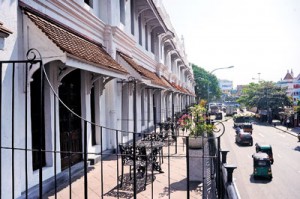
Heritage building: The 135 year-old hotel had its beginnings as barracks for British soldiers
For the newly refurbished, 130-year-old Hotel Nippon, nostalgia has been a powerful pull for its customers. Once when Vishnu K.Vethody, Managing Director of Hotel Nippon,was passing through the hotel’s coffee shop, he noticed a woman in her seventies seated at one of the tables. She was gazing out through the window, absorbed in quiet thought. He walked over to strike up a conversation and she confessed to him that she had simplywanted to be in the building. The hotel used to be a spot where she would come with her father, 60 years before and was a place replete with poignant memories — “We didn’t talk much but that used to be our time,” she reminisced.
One of the highlights of the hotel’s reopening has been the anecdotes and personal memories that the hotel’s customers bring with them when they pop in for a snack or meal.Hotel Nippon has been through many reincarnations and is classified as a heritage building in Colombo. Initially used as barracks for British soldiers and built as apartments, the hotel was purchased by a Polish migrant named Greg Roszkoswki. Formerly Manning Mansions (the original name is still visible above the main entrance) and Hotel Polski, the name ‘Nippon’was a nod to his Japanese wife. The hotel was then passed onto his son (also named Greg and who also went on to marry a Japanese) who was a popular announcer on Radio Ceylon in the 1950s. Greg Roszkoswki Jr was a founder member of the Otter Aquatic Club in Colombo and was purportedly known for his catchphrase ‘wakeywakey’ and for his jovial nature and outlandish pranks.
Greg Roszkoswki Jr and his wife invited Vethody Kumaran, who was running the National Restaurant near Regal Cinema, to join the business. Kumaran had come to Ceylon from Kerala, joined the army service corps during World War II and had opened a small electric shop off Skinner’s road after demobilization. An obituary for Vethody Kumaran speaks highly of his peace-loving nature and of Hotel Nippon’s halcyon days. “Soon the Hotel became well known for Mrs. Roszkowski’s sukiyaki dishes as well as for Mr.Kumaran’s mutton rolls and devilled prawns which were obtainable in plenty those days,” writes P.M. Pieris in a eulogy. Later, Vethody Kumaran went on to become the owner of the hotel,which is currently owned and run by his sons.
The 135 year-old hotel has had a hefty Rs. 400 million makeover and recently reopened with revamped service, rooms and food but maintaining strong vestiges of its past. The hotel’s post-war refurbishment was undertaken by Vethody Kumaran’s sons – V.K. Valsan, V.K.Vasan, V.K. Chandrasena and the late V.K. Prasannan who passed away last year. The hotel’s management seem keen to find the sweet spot between nostalgia, affordability and maintaining its edge in Colombo’s mushrooming city hotel scene. There’s also the added challenge of countering the reputation it accrued during years of neglect during the war–Hotel Nippon is situated in the heart of Slave Island, classified as a high-security zone during war years. In 2008, a part of the hotel was considerably damaged by a bomb which killed four people and injured many more.
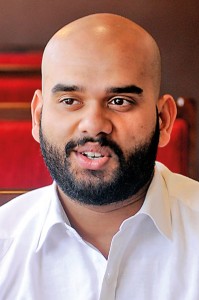
MD Vishnu K. Vethody
Today, Hotel Nippon’s red brick façade of the 50s and 60s has been eschewed for a minimalist white and wrought iron exterior with accent on wood. Marble floor tiles gleam under soft lighting and there’s steady footfall in the Nippon Hotel’s Kafe.
There are certain popular Colombo eats which take on mythic proportions over time and are laced with nostalgia–Hotel Nippon’s Mutton rolls is one of them. Dr.Valsan Vethody, one of V.K. Kumaran’s sons and a director of the hotel, points out that it’s been hard to pinpoint when and why the rolls became popular and states that the hotel may have begun serving the deep-fried snack as many as 80 years back. “After my Advanced Level I worked at Nippon as a cashier for a few months for work experience. That time I remember we were selling it [mutton rolls] for 50 cents. If I remember it correctly, we used to sell 1500 – 2000 rolls a day. Parcels after parcels after parcels– just the rolls,” he reminisces. “I remember those days, Nippon used to be very famous for rolls, Nippon onion sambol and the mixed grill. We also used to have Japanese dishes such as sukiyaki and chowmein.”
T.D. Ranaweera Aranayake (63) has been making and serving up Hotel Nippon’s mutton rolls for 35 years and seems bemused by this hype. The recipe which is currently used is the original one which used to draw hundreds to Hotel Nippon. The secret behind its taste? Less ingredients rather than more Ranaweera Aranayake avers, smiling. The café also serves short eats, cakes, filter coffee and other beverages. The Calicut crunch or Kahja, a popular tea-time snack in Kerala, was a personal favourite.
Managing Director Vishnu Vethody quips that when Hotel Nippon was in the middle of its rebranding and refurbishment, ‘Hotel Nippon – Not just for mutton rolls’ was light-heartedly considered a tagline to highlight the hotel’s offerings beyond its rolls. The hotel’s rooms have been refurbished and are on par with other city hotels and its small hall (Crimson 123) and bar (The Cabinet) have been given a facelift. But its diamond in the rough is its restaurant ‘The Bamboo Room’.
During the day, the restaurant dishes out Sri Lankan cuisine but a visit at night is warranted to taste the restaurant’s traditional Kerala and South Indian menu which packs a punch. Fiery prawn and mango curry, mutton varuttiyathu (meat marinated in herbs and stir-fried with slivers of coconut) were delicious, if slightly spicy accompaniments to our Kerala parotta and dum biriyani. The meenpollichathu we sampled was a whole fish marinated in spices, wrapped and steamed in a banana leaf and smothered in gravy. For those less inclined towards spice, the appam dipped in traditional chicken stew was equally flavourful but without the pungent heat. The restaurant’s dessert menu however, was at odds with its mains (watalappan, lava cake) and paled in comparison to the menu’s heavyweights.
The restaurant is still in its early days and its Kerala menu is served only at night. The menu notes that the restaurant hopes to branch out to other types of cuisine – for the sake of the restaurant’s identity, we sincerely hope it doesn’t. Far too many Colombo restaurants have fallen into the trap of sprawling menus, unimaginative food and no distinguishable identity. It’s still a bit rough around the edges but The Bamboo Room has plenty of potential. Perhaps we could be bold enough to suggest an alternate tagline for the hotel – Hotel Nippon: Come for the mutton rolls, stay for the Kerala cuisine.
For now, Hotel Nippon’s new chapter has only just begun and an old once-dilapidated heritage building has been given a new lease of life. Colombo has seen a glut of city hotels but the gilded, more luxurious hotels lack the pre-loaded history of Hotel Nippon and this could be one of the hotel’s biggest strengths.
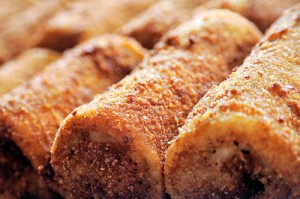
The taste of Nippon Hotel over the years: Its famed mutton rolls
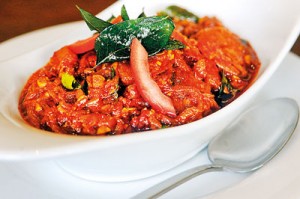
A spicy Kerala dish. Pix by Amila Gamage
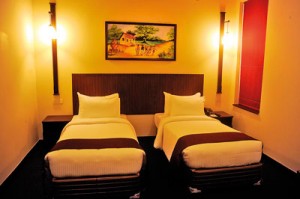
Refurbished: The rooms at Hotel Nippon


